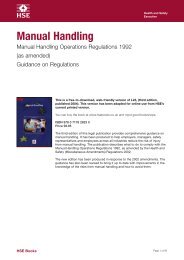Making Companies Safe - what works? (CCA ... - Unite the Union
Making Companies Safe - what works? (CCA ... - Unite the Union
Making Companies Safe - what works? (CCA ... - Unite the Union
Create successful ePaper yourself
Turn your PDF publications into a flip-book with our unique Google optimized e-Paper software.
Health and <strong>Safe</strong>ty Management System<br />
A fundamental prerequisite of <strong>the</strong> incentive-based approach suggested by Gunningham and<br />
Johnstone is for ‘track two’ companies to have implemented a SMS with prescribed minimum<br />
components. 109 As stated above, <strong>the</strong> HSE are also considering whe<strong>the</strong>r one criterion should<br />
be that <strong>the</strong> organisation has a OHS management system that could be measured against<br />
some standard. 110 However, as we have seen from <strong>the</strong> evidence discussed above, adoption of<br />
a formal SMS does not, in and of itself, guarantee improved health and safety performance,<br />
let alone guarantee <strong>the</strong> quality of performance that would be necessary to grant a company<br />
‘autonomy’ from regulatory inspection and intervention. Therefore, while <strong>the</strong> existence of a<br />
SMS may be a condition for earned autonomy status in <strong>the</strong> belief that it will help good<br />
performers to achieve an adequate level of internal self-regulation, it is not an effective tool<br />
for identifying ‘good performers’.<br />
More concerning is evidence that in some cases SMS may exert a negative influence on health<br />
and safety. Nichols and Tucker have argued that in countries like <strong>the</strong> UK, where neo-liberal<br />
policies are in ascendance and trade unions are in retreat, <strong>the</strong>re may be a tendency for firms<br />
to adopt (and for workers to be unable to resist) OHS management systems that stress<br />
management control of workers’ behaviour, result in victim-blaming and fail to address <strong>the</strong><br />
real causes of occupational injury and ill-health. Gunningham and Johnstone acknowledge<br />
that certain kinds of SMSs – such as <strong>the</strong> DuPont <strong>Safe</strong>ty system and SMSs based on ISO 9000<br />
or 1404 – are unlikely to secure real health and safety improvements, 112 and suggest that<br />
authorities should require that organisations implement a SMS with prescribed minimum<br />
components. However, it is not clear how this will prevent organisations from implementing<br />
<strong>the</strong> wrong kind of SMSs. Gunningham and Johnstone’s minimum criteria 113 closely resemble<br />
HSE’s guidance, Successful Health and <strong>Safe</strong>ty Management, (HSG65), which in turn is<br />
entirely compatible with hierarchic, behavioural-based SMSs. 114 This is demonstrated by <strong>the</strong><br />
fact that Royal Mail turned to DuPont’s <strong>Safe</strong>ty and Environmental Management Services<br />
division in order to achieve compliance with HSG65. 115<br />
While no international audit has been done to assess how many companies have adopted<br />
<strong>the</strong> various proprietary SMSs, <strong>the</strong>re is evidence to suggest that <strong>the</strong> number of employers<br />
adopting <strong>the</strong> marketed systems are multiplying, and that <strong>the</strong>y are sold to medium and large<br />
employers, often in petrochemical and o<strong>the</strong>r high-risk industries. 116 And <strong>the</strong>re are three facts<br />
that suggest that firms seeking to comply with regulatory guidance or firms seeking certain<br />
administrative or public relations benefits will turn to SMSs like <strong>the</strong> DuPont system.<br />
First, commercial organisations and consultants aggressively promote <strong>the</strong>se products. Second,<br />
it is precisely <strong>the</strong>se types of SMS that are likely to prove popular with management since <strong>the</strong>y<br />
emphasis management control and provide relatively easy tools to measure progress. And<br />
third, even though employees are frequently unhappy with such systems, it appears that <strong>the</strong>y<br />
are usually unable to resist <strong>the</strong>m. 117 This was true even of <strong>the</strong> historically strong and highly<br />
organised Norwegian offshore oil workers when workers perceived that <strong>the</strong> adoption of <strong>the</strong><br />
DuPont and International System of Ranking <strong>Safe</strong>ty (ISRS) systems by a number of oil<br />
companies had undermined <strong>the</strong>ir rights to participation under <strong>the</strong> Work Environment Act. 118<br />
These examples illustrate that marketed SMSs may also become prevalent in countries that<br />
have mandated forms of OHS management.<br />
Injury and ill-health incidence rates<br />
The HSE have also suggested that firms could be considered for earned autonomy status on<br />
<strong>the</strong> basis of ill health and injury (presumably major and fatal injury) incidence rates. However,<br />
<strong>the</strong>re are a number of problems with <strong>the</strong>se as a predictor of effective OHS management. 119<br />
First, and as acknowledged by <strong>the</strong> HSE, <strong>the</strong> small numbers employed in SMEs make <strong>the</strong> data<br />
on incidence rates unreliable as a measure of company performance. The HSE have <strong>the</strong>refore<br />
suggested that lost-time or sickness absence might be preferable measures. But research on<br />
trends in occupational injury and death show that reported lost-time incidents are an<br />
unreliable predictor of health and safety conditions within <strong>the</strong> workplace and may actually fall<br />
at <strong>the</strong> same time as major injury and fatality rates rise. 120 The same is likely to be true for<br />
sickness absence, with a recent survey by <strong>the</strong> TUC showing that three out of every four<br />
employees had been to work when ill during <strong>the</strong> past year. 121 95
















